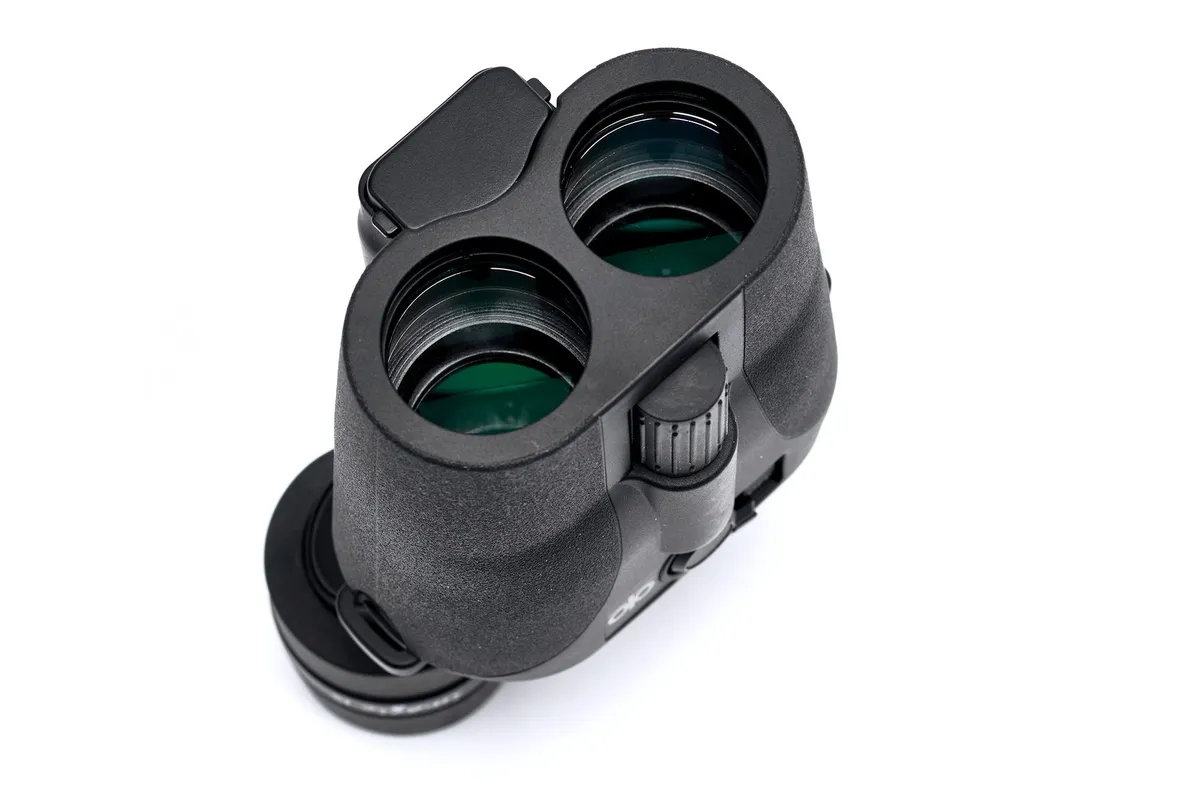A new player in the world of image-stabilised binoculars is bound to be of interest, so we were eager to find out how Opticron’s latest model, the Imagic IS 12x30, performed. We were far from disappointed.
Like all image-stabilised models, the Imagic IS 12x30 binoculars have a one-piece body with adjustable eyepiece turrets.
The binoculars come with a tough, lined and padded vinyl case, a comfortable neoprene neck strap and a choice of individual eyepiece caps or a tethered rainguard.
Both options fit well, although there is no cap for the objective lens end. The set is completed with a good quality microfibre cloth in a wallet, a comprehensive instruction booklet and an intriguing ‘anti-flip’ loop.
The body is covered with a textured nitrile rubber armour that gives a very secure grip, even when it is damp, and also offers some protection against the inevitable bumps to which all well-used binoculars are subjected.
There are internal roof prisms and a Porro prism system in each of the eyepiece turrets, which you rotate in order to adjust the interpupillary distance (IPD) – the distance between the centres of the pupils of the eyes.
The eyepieces move smoothly and are stiff enough to prevent inadvertently changing the IPD.
They are specified as IPX-4, meaning they are splash proof. The focuser is near the objective lens end of the body and is light, smooth and without backlash.

The right eyepiece dioptre adjustment is suitably stiff and also moves smoothly. The image stabilisation is activated by a switch on the top of the body. These are robust binoculars with good ergonomic design.
The four-position eyecups twist down to 2mm above the surface of the eye-lenses, so only 13mm of the specified 15mm eye relief is available.
This was just enough to be able to see the entire 5˚ field of view when we wore spectacles.
If you prefer observing without spectacles, there is enough focal range either side of infinity focus to accommodate visual focal defects, and the 2.5mm exit pupil is small enough to reduce the effect of mild astigmatism (an imperfection in the curvature of the eye’s cornea).
The image-stabilisation technology makes focusing a doddle. There’s no region of ‘is it or isn’t it’; it snaps to a very crisp and obvious focus.
The focus is very sharp across the central two thirds of the field of view, outside of which there is slight field curvature.
Shining a bright light into the objective lenses demonstrates the effectiveness of the anti-reflective multi-coatings.
There are baffles in the light path that control stray light extremely well and we were unable to induce spurious ghost images with a gibbous Moon in, or just outside, the field of view.
Colour correction and colour rendition are both good. False colour on high contrast objects is imperceptible at the centre of the field of view and is well-controlled over most of the rest of it, only becoming obtrusive towards the edge.
Opticron advertises the Imagic IS as being suitable for lunar astronomy, and we could see no false colour at all on the terminator when it was in the middle of the field of view.
The light grasp of a 30mm aperture is obviously limited by the laws of optics, so this is not going to be a good choice for most deep-sky objects.That said, it is quite effective on some of the brighter ones.
The open cluster M35 in Gemini initially appeared as a slightly granular glow with two stars resolved, but when we activated the image stabilisation (IS), six more stars appeared in and around this glow.
It is also useful for splitting wide double stars. For example, we could not split 145 Canis Majoris (with a separation of 27 arcseconds) until we activated the image stabilisation, which proved just how important it is.
The new stabilisation system delivers well, making the Imagic IS 12x30s suitable for those who want small and lightweight multi-purpose image-stabilised binoculars.
These will be useful for non-astronomical purposes and will occasionally complement your main astronomical observing equipment.

Superb sky views
Opticron’s image stabilisation (IS) system was developed in collaboration with a leading Japanese optical systems designer.
It is activated by a small lever on a rotary toggle switch that is conveniently placed for operation with your right forefinger.
Instead of time-out circuitry, there is a small green LED that is immediately apparent when you take the binoculars away from your eyes, reminding you to switch the system off.
The IS system is based around gimbal-mounted prisms and is specified as being able to correct for instability with an amplitude of up to 3˚.
It’s effective at eliminating rapid, low magnitude ‘shakiness’, the vibrations that reduce the effectiveness of hand-held binoculars if you are trying to resolve detail.
When you pan slowly across the sky, the image moves smoothly with you. However, if you move quickly and come to an abrupt stop, there is a bit of a tendency for the image-stabilisation system to over compensate slightly before it settles down, but we did not find this to be irksome.

Very good optics
The combination of excellent anti-reflective coatings on the lenses and Opticron’s proprietary Oasis phase-coatings on the roof prisms helps the binoculars to transmit the full visible spectrum without the colour balance being affected by interference in the prisms. The result is faithful colour rendition and very good image contrast.
Good IPD range
With the interpupillary distance (IPD) – the distance between the pupils of the eyes – ranging from 54–74mm, the Imagic IS 12x30s will suit a wide variety of faces. The 41.5mm diameter eye-cups mean there is 12.5mm between them at the minimum IPD, which should be sufficient for most people’s nose bridges.
Internal focusing
The focusing mechanism works by moving an internal lens group. This has the advantage of eliminating a potentially ‘rocky’ eyepiece bridge that can compromise focusing if your eyes press on the eyepieces. It also makes it easier to prevent ingress of damaging moisture and dust.
Readily available batteries
The image stabilisation uses two AAA batteries (four are included), which have a specified life of 12 hours – but expect it to be less in cold weather. These are widely available, so you can easily source replacements but, if you can’t, you can still use the 12x30 binoculars, albeit without stabilisation.
Anti-flip loop
The design of the 12x30 binoculars means that neck strap lugs at the eyepiece end of the body will be close to the centre of mass, leading to a tendency for them to flip horizontally through the strap. Opticron’s simple and remarkably effective solution is a loop that pulls the straps together.
Vital stats
- Price £519
- Optics Fully multi-coated
- Aperture 30mm
- Magnification 12x
- Prisms Roof (internal) and Porro (eyepiece turrets)
- Angular field of view 5°
- Focusing Centre focus, moving internal lens group
- Eye relief 15mm
- Interpupillary distance54-74mm
- Weight 537g
- Supplier Opticron
- Tel +44 (0)1582 726522
- www.opticron.co.uk
This review originally appeared in the March 2020 issue of BBC Sky at Night Magazine.
